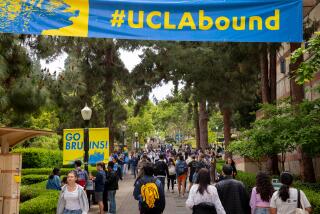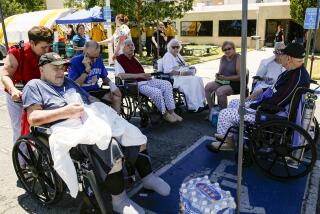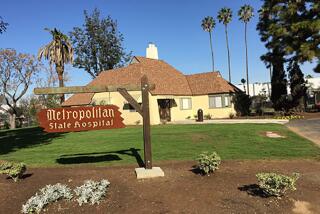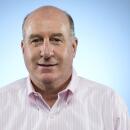Plans OKd to Build Hospital at UCSD
- Share via
Detailed plans were approved Thursday for construction of a 120-bed hospital on the UC San Diego campus.
Two committees of the University of California Board of Regents voted for the $74-million facility in La Jolla, which is meant to attract patients from the growing and affluent North City and North County areas.
The existing UCSD Medical Center, 12 miles away in Hillcrest, has had financial troubles because so many of its patients are indigent or have no private medical insurance. The Hillcrest hospital will remain open, although its capacity will be cut from 447 to 327 beds.
Regents Expressed Concern
Some UC regents said they are worried that the inner-city hospital will become even more an institution for the poor once the La Jolla hospital opens. But other regents, along with UCSD officials, rejected that argument and stressed that the Hillcrest facility needs the income the La Jolla facility will generate.
“The risks attendant to proceeding are fewer than those the university will confront if the university does not proceed,” said David P. Gardner, president of the UC system.
The hospital, to be named the Satellite Medical Facility, will be on a bluff on the east side of Interstate 5, across the freeway from the UCSD Medical School. Completion is scheduled for the end of 1991, officials said.
Regents were shown drawings of the new facility Thursday and praised what they saw. The hospital is to consist of three linked buildings, each two to four stories high. A glass atrium walkway and an outdoor courtyard are central features of the design.
Despite design changes and expansion that raised the price of the hospital from $62 million last year to $74 million, approval by the full Board of Regents is expected today, officials said. The project is to be financed through loans from private sources, to be repaid with revenues from the hospital.
UCSD Chancellor Richard C. Atkinson said the hospital will help the Medical School financially as well make it more convenient for scientists on the main campus to work on medical research.
‘One More Milestone’
“It’s been a four-year effort, and we’re delighted to go through one more milestone,” V. Wayne Kennedy, vice chancellor of administration at UCSD, said after the votes by the building and finance committees. “If things go well tomorrow, we should let the first contract about nine months from now.”
Kennedy and other UCSD officials have been working feverishly for several weeks to prepare a convincing proposal for the regents.
They have been particularly sensitive to criticism that the satellite hospital would fragment the patient base, putting those who are poor in the Hillcrest facility and the more affluent in La Jolla.
Gerard N. Burrow, dean of the Medical School, said in an interview last month that UCSD will guard against that by not duplicating specialty services between the facilities. Current plans will keep pediatrics, obstetrics and gynecology, cancer treatment, the burn unit and organ transplants exclusively at Hillcrest, he said. That hospital also will remain part of the county’s trauma network for victims of severe accidents.
In addition to general medicine and surgery, the La Jolla hospital will provide specialty services such as gene therapy, a field in which the school has leading researchers, and geriatrics. There are no plans so far at La Jolla for a magnetic resonance imaging machine, an expensive, state-of-the-art tool that patients probably will go to Hillcrest to use.
“It’s not two hospitals in a single system. It’s a single hospital in two sites,” Burrow said.
Burrow and others have also emphasized that removing 120 beds from Hillcrest will open up space for private and two-bed rooms, family waiting rooms and other facilities that don’t exist there. They say they believe the changes will make the hospital more attractive to both the public and doctors.
At a meeting in June, regents made it clear they were seeking ways to make the hospitals in the UC system attract a more affluent “patient mix”--a higher percentage of privately insured patients. That is because government insurance programs are paying shrinking percentages of the amounts they are billed for care. The Medi-Cal program for indigents, for instance, pays only about 50% of the amount billed.
In 1987, UCSD Medical Center had to write off $55.7 million because of government underpayments and bad debts of uninsured patients.
More to Read
Sign up for Essential California
The most important California stories and recommendations in your inbox every morning.
You may occasionally receive promotional content from the Los Angeles Times.











